New KITE APC 50 Binoculars: Next-Level Image Stabilization
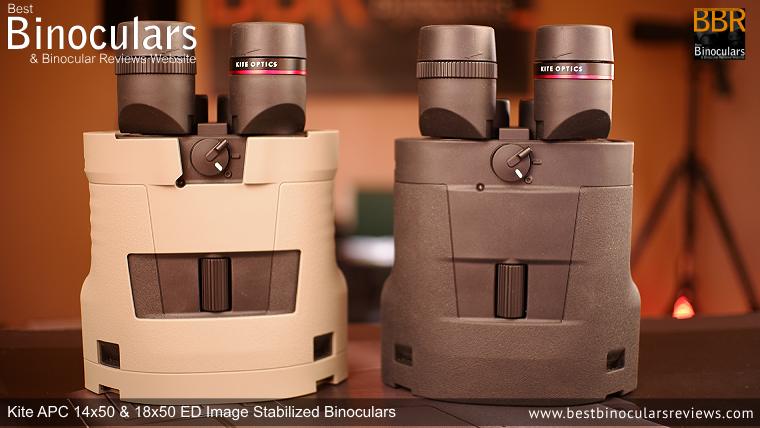
In this article, I Introduce the Second Generation Kite Optics APC 50mm Binoculars and explain what makes the Image Stabilization on Kite Optics APC binoculars different and I think superior to all that has been available in the past.
I will also cover what they have improved on the new versions, including an improved optical system, updated software and improved gimbal system that truly elevates the levels of Image Stabilization and thus the experience of using IS binoculars to new heights.
Over the last few months, I have been using and rigorously testing the latest Kite APC 50 Image-Stabilized Binoculars in both the 14x50 and 18x50 configurations. These new additions to the Kite Optics lineup of IS binoculars have seriously impressed me with not only how well the image stabilisation works, but also their new features and improved optics that in my experience using them result in even better views than before.
Indeed I would say that from a user’s perspective not only do they surpass Kite’s previous APC models (like the 16x42 version I have previously reviewed), but I truly feel they also now set the standard when it comes to image stabilization binoculars.
So as a part of my full reviews on these binoculars which will focus more on the user experience, I wanted to go over the technical aspects of these instruments in a separate article as it is the same for both and try to explain what I have uncovered in my research, decipher and hopefully clarify the technologies involved, the main advancements that Kite has made from their previous models and compare them to other IS binoculars on the market so we can see what sets them apart.
Main Details, Features & Improvements:
More Advanced, Compact & Effective Image Stabilization:
According to Kite, they have invested more than a decade’s worth of research into their IS system and they now have it to where it is truly industry-leading technology which they are justifiably proud of.
So what makes their system different and so special from the others? Well, I have been able to see the results first-hand and it is impressive just how well their IS works, but under the covers, this is what I have managed to find out so far as to how it works:
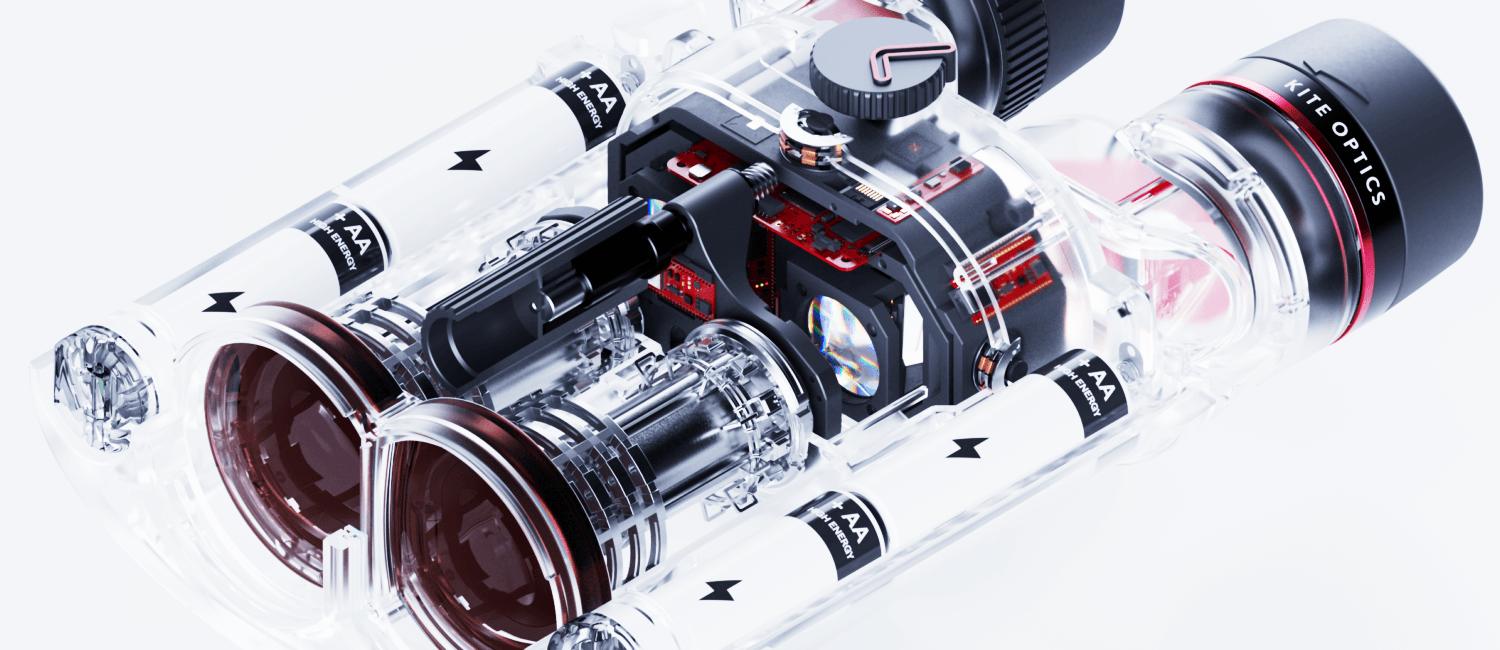
Instead of the lens shift or Porro prism correction used by the other players in the IS binocular sector, Kite APC binoculars have a stabilisation system that uses roof prisms, which just as in standard non-IS binoculars means that they have been able to produce a more compact, instrument:
So up until recently, the technology behind image-stabilized binoculars was primarily based on either lens shift mechanisms or Porro prism correction, both of these systems use gyroscopes and electromotors. Whilst they work, both of these systems result in bulky, heavy binoculars that have a limited battery lifespan, and often lack comprehensive waterproofing:
Lens Shift Image Stabilization
The optical lens shift system sometimes found in some high-end camera lenses uses regular lens elements within a suspended system that offers excellent clarity and correction of fairly extreme movement.
So because of this, I am not 100% sure if this is the same system that is used with Image-stabilized binoculars that employ lens shift. I say this because whilst these IS binoculars are capable of delivering accurate stabilization, they are often limited by a narrow correction angle. This means they can only effectively counteract minor movements or vibrations, which is not true of camera lenses that use lens shift. If anyone has any further info on this, please feel free to contact me or comment on this post.
Porro Prism Stabilization
So as far as I know, there are three main types of IS that utilise Porro Prisms to stabilize the image:
- Gyro Porro Prism IS
- Vari-Angle Porro Prism IS
- Mechanical Image Stabilisation
Gyro Porro Prism Image Stabilization
Good examples of this type of IS are the Fujinon’s Stabiscope binoculars which have a high-speed motor-driven gyroscope attached to the prisms.
IS binoculars that use the Gyro Porro prism stabilizer system often have an improved correction angle, and so can effectively handle more substantial movements.
Fujinon Techno-Stabi and Stabiscope binoculars can correct between 3 and 6 degrees of motion.
However, the problem is the Porro prism’s inherent size and weight. Not only does this in itself increase the size of the binocular, but these larger prisms also require larger motors for control.
There is also a delay while waiting for the high-speed motor to start up. The result is a stabilized image that is slow and wavy, which leads to a sensation akin to ‘seasickness’ for some users.
The Gyro system is also not able or not as good at differentiating between panning movement and image shake, therefore the image is often not stable whilst panning the view.
Additionally, because of the powerful motors, these devices usually have a relatively short battery life or use many/large batteries.
Vari-Angle Porro Prism Image Stabilization
Canon’s IS Binoculars and their “Vari-Angle Prism” IS system are good examples of binoculars that use this type of image stabilization technology in their instruments. They have a couple of sensors that detect any vertical or horizontal movement and “Vari-Angle Prisms” that are controlled by a microprocessor that adjusts the refraction angle of the incoming light to counter the movements.
The downside to these is they only have relatively narrow correction angles – Canon IS binoculars can only counter between 0.7 and 1.0 degrees.
Mechanical Image Stabilisation
Zeiss 20x60S Professional binoculars use this system where their Porro prisms combine with a Cardanic Suspension system, which is similar to the gimbal suspension system that is often used for mounting compasses.
The advantage of this type of IS is that the action works immediately at the touch of a button and without the need for any battery power.
The disadvantages include the system is large and heavy and like the Gyro Porro prism system is unable to distinguish between shake and panning therefore the image is not stable when panning the view.
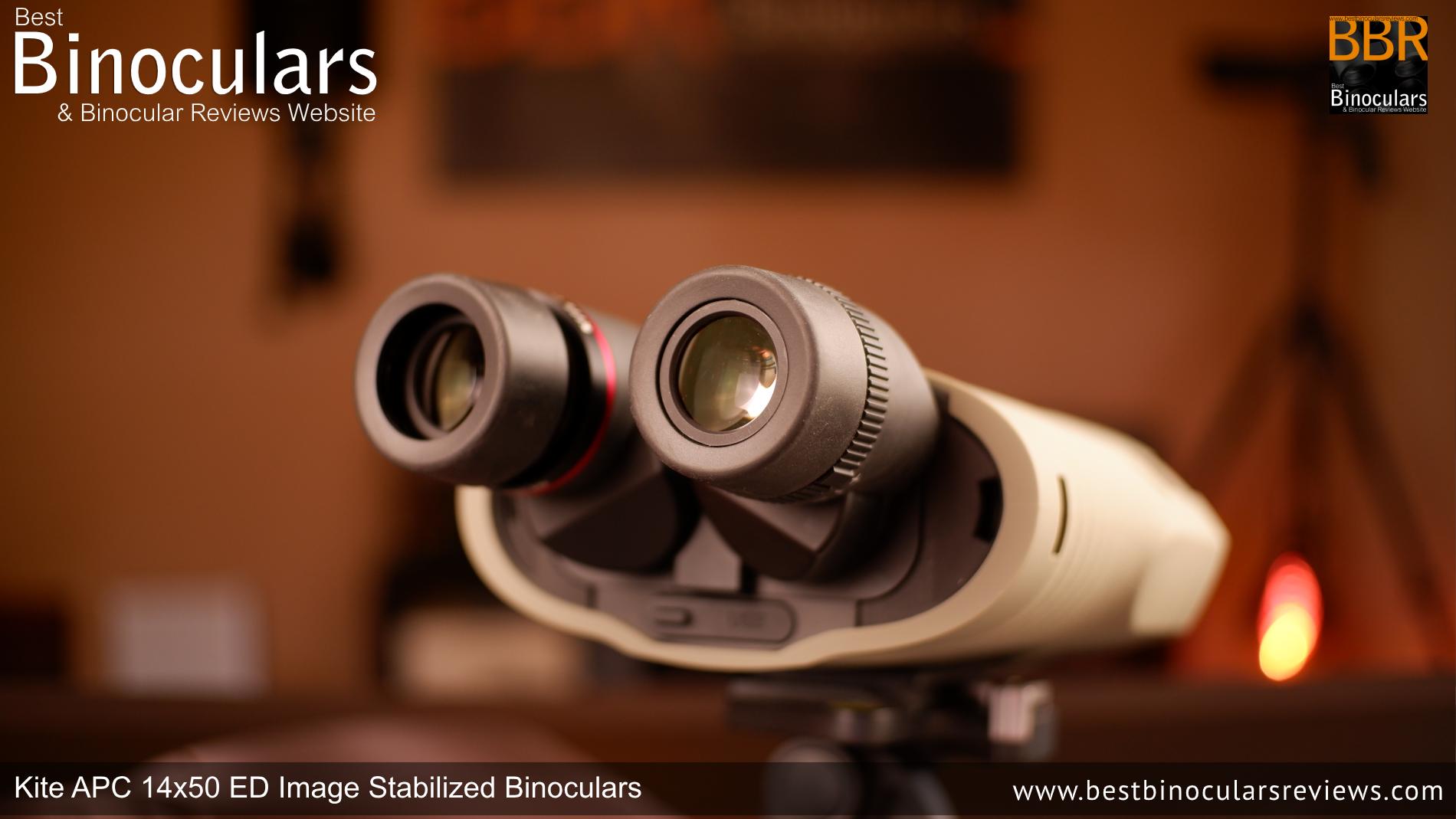
Kite’s Roof Prism Stabilization
Unlike the two main options above that use porro prisms, Kite APC binoculars have a stabilisation system that uses roof prisms, which just as in standard non-IS binoculars means that they have been able to produce a more compact, instrument that uses smaller, faster-reacting, accurate stabilization with a relatively large correction angle:
Kite APC 50mm binoculars have a stabilisation correction angle of 2 degrees.
Using roof prisms in the optical path of a binocular does not allow for stabilization with gyroscopes where there is a delay.
Instead, a roof prism requires active control to effectively operate within the binocular’s optical path. The breakthrough that Kite have made comes in the form of a unique gimbal suspension system where an array of accelerometers continuously monitors every stationary and moving component.
Then Intelligent software dynamically adjusts the movement of each component, achieving a state of perfect equilibrium and coordination.
Dynamic Gimbal System (KDGS)
At the heart of all Kite Optics Image-stabilised binoculars (including the 50mm APCs and the APC 42 and APC 30 models) is their Dynamic Gimbal System (KDGS).
As far as I have ascertained, the currently available APC 30 and APC 42mm binoculars use Kite’s KDGS-1 suspension system, equipped with second-generation accelerometers that can provide a 3-degree correction angle and unlike many other image-stabilized binoculars that rely on passive stabilization using a gyroscope, the KDGS actively controls the prism through sophisticated onboard software which they say has improved response speed and higher precision.
2nd gen. Kite Dynamic Gimbal System (KDGS-2)
The new Kite APC 50 Binoculars are equipped with a second-generation Kite Dynamic Gimbal System (KDGS-2). This improves on their KDGS-1 enhancing the level of image stabilization and thus increasing the stable viewing experience.
The result is with the new Kite APC binoculars, you truly do get a deeper feeling of immersion when looking through them because the view is so steady. It is hard to explain and I don’t think the video footage I have captured through them conveys it, but the sensation of looking through binoculars almost vanishes entirely, allowing you to feel more a part of the scene before you.
KT 3.0 Software
As well as the hardware, another improvement that Kite has made on these APC 50s is with their software that controls the IS system:
Kite KPC 42 binoculars use their second-generation KT2.0 software, whilst these latest APC 50 binoculars, use their updated KT 3.0 Software which they say is a significant leap forward that “mirrors the cognitive and visual patterns of the mind, effectively making the sensation of looking through binoculars vanish.”
Longer Lasting Image Stabilisation
APC = Angle Power Control
With most IS binoculars, you have to turn them on and then either remember to turn them off, or they may even have a timer to save battery, but even so, if you are just quickly looking at something like a bird in a tree, you don’t ideally want the instrument to be left on for 5 minutes or so before auto powering down.
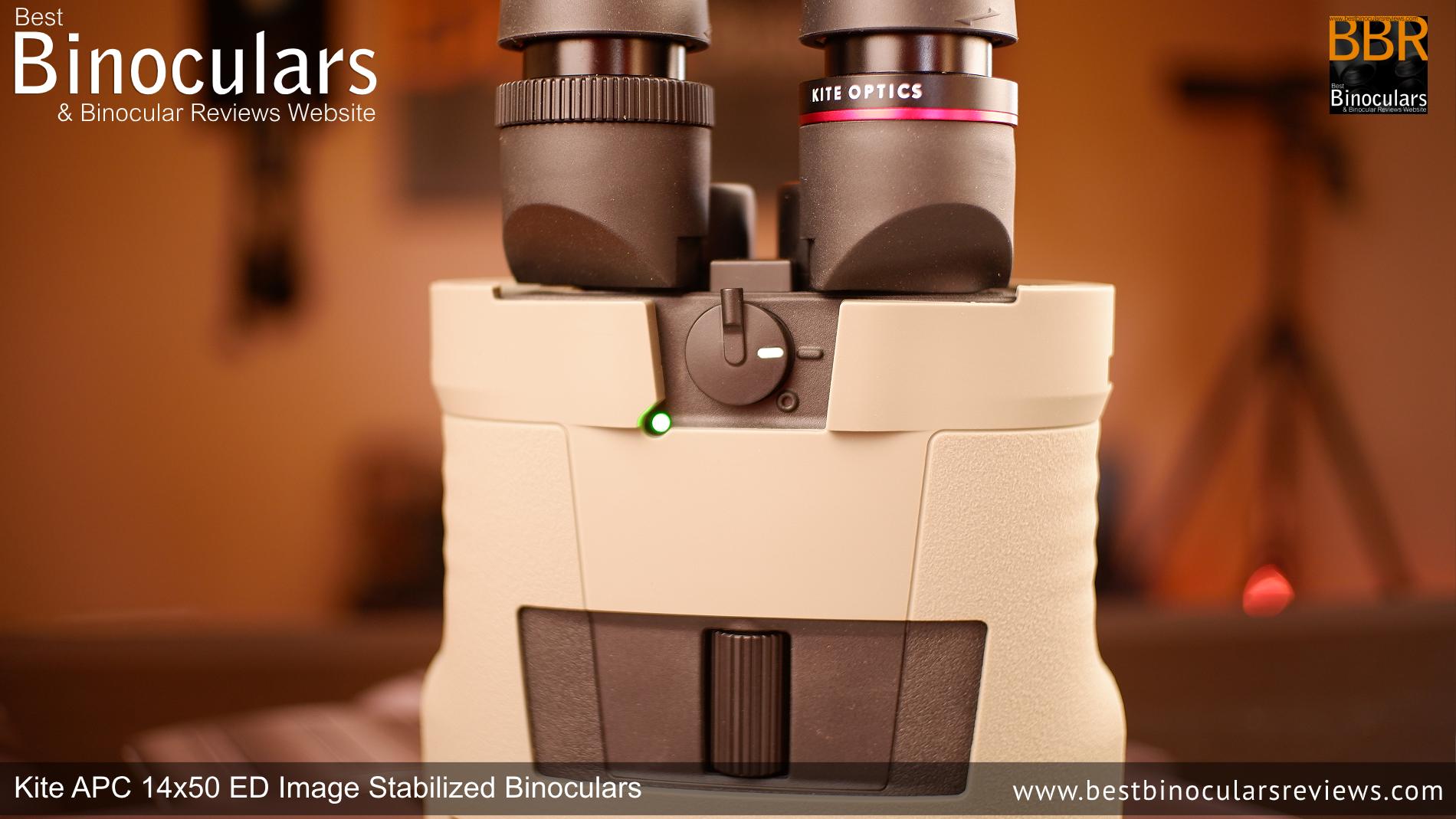
With the Kite APC binoculars, there is an on-off switch ideally positioned in between the oculars behind the focus wheel, but once you have it on, the rest is taken care of for you automatically in a pretty ingenious way:
There are sensors in the binoculars that detect the angle at which the instrument is positioned, so as you tilt them up to your eyes, the IS turns on and then goes into sleep mode when you point them down, like when you hang them down around your neck, which prevents any more power consumption and if there is no activity for a long time, the system will completely turn off.
The result is that they are more like using a standard optical-only binocular as you don’t have to constantly turn them on and off again. This system also means they have an advertised battery life of up to 38 hours … of continuous use, which is far more than any others I’ve come across.
This means for most people you will be able to use them for what Kaite calls an “entire season” before needing a charge. I have used my samples a lot already and so far I have not seen the low battery indicator… so I can’t tell you if that works or not!
Different Power Options – USB-C and AA Versions
In terms of powering electronic devices like these, there will be some who prefer the universal availability of AA batteries and being able to replace them when needed (these can be good for those who travel to remote locations where there is no electricity), whilst there are others who want the convenience of a permanent onboard rechargeable battery.
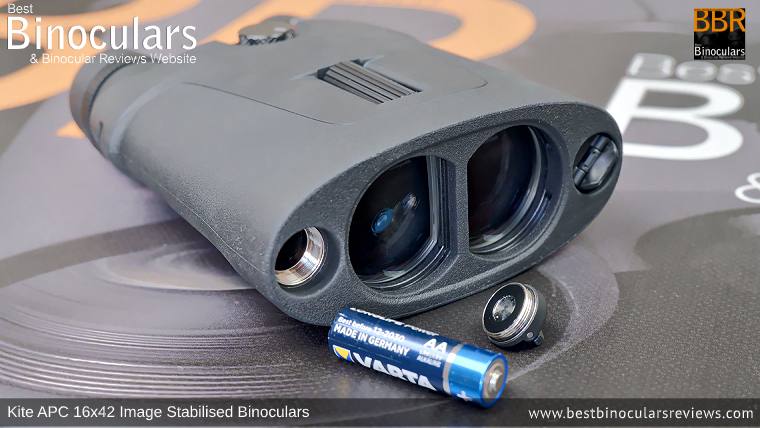
With the Kite APC binoculars, not only do you rarely need to charge or replace batteries, but you also get the choice based on your preference. Both the 14x50 and the 18x50 models are available with either replaceable AA batteries (they take 2x) or an integrated Li-ion battery that is rechargeable via USB-C, which I think along with the APC system shows excellent attention to detail in regards to the overall user experience.
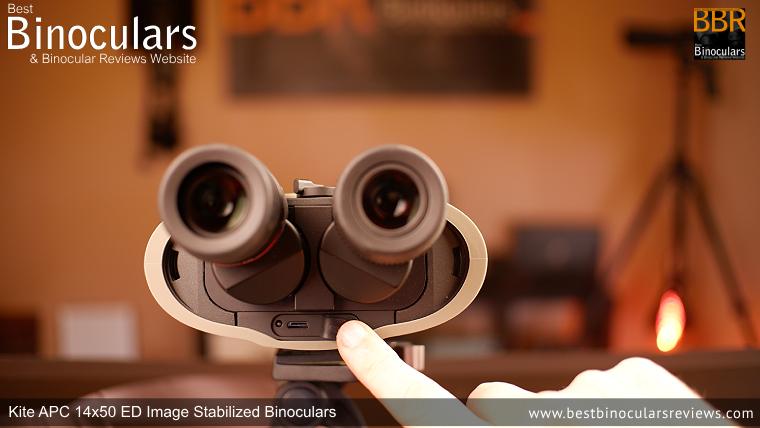
Improved Optics
Another improvement that I like is that as well as the Image stabilisation stuff, the level of optics has also been improved on the new Kite APC 50 binoculars to a level not seen on any IS binocular before:
ED Glass

The more you magnify an image the more obvious any level of color fringing (caused by chromatic aberration) becomes.
Thus I was particularly happy to discover that unlike most other IS binoculars on the market, including Kite’s other APC models, that use a standard optical class (with a low dispersion factor), the new APC 50 come with a fully Extra-low dispersion (ED) glass system that provides improved correction of chromatic aberrations.
Indeed despite having higher magnifications than “normal”, to me, it looks like chromatic aberration (seen as color fringing in the view) has been reduced, to the levels I would expect to see on high-end 10x binoculars, which is impressive.
Optical Coatings
The quality glass and KITE MHR Advance+ coatings used on these reportedly help these binoculars achieve an 86% light transmission level through the system, which is impressive, even for optical-only binoculars that have less complicated pathways. This combined with the large 50mm lenses means that despite the high 14x and 18x magnifications, they do well even in low-light conditions (To put this in perspective, to my eyes they look to match quality 10x32s and even 10x42s).
Field of View
High-power binoculars that have a very narrow field of view make it difficult to locate your subject and I find you often end up missing all the action on the periphery of the view!
This is not the case with these 50mm APCs because, despite the powerful 14x and 18x magnifications, I find that looking through them does not feel that much different from when using a standard 10x or 12x binocular (especially with the 14x50 Kite APC).
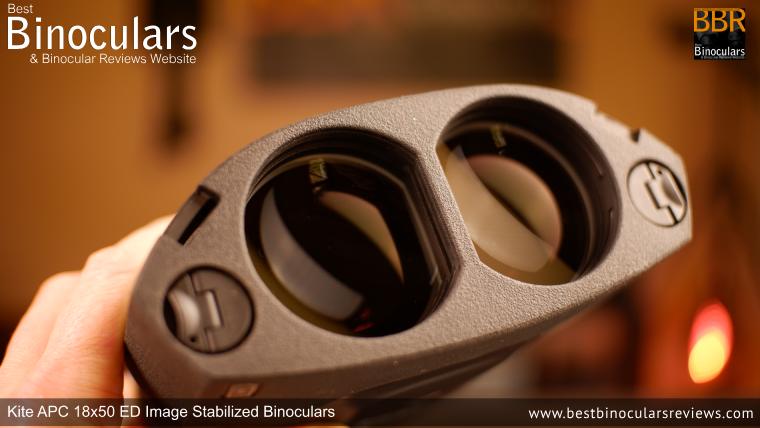
Larger 50mm Lenses
If you look at my review of the Kite APC 16x42 Image Stabilised Binoculars, you will find that one of my slight reservations about them was the fact that whilst they vastly increase the magnification (compared to a typical 8x or 10 binocular), they decided to keep the same sized 42mm lenses that you find on most standard binoculars.
Combined with the roof prisms, this does make for a nice, relatively compact instrument, but at the same time, this configuration reduces the exit pupil down to just 2.6mm (42÷16).
Considering the good level of optics used by Kite and resultant transmission levels, for most normal use, this is no issue at all, but if you really want a binocular with superior low-light performance, this small exit pupil means these can be found a little wanting for some users. For more read my complete guide to the exit pupil.
So now with the new APC models, you have another option, because with their larger lenses, yes they are a little bigger to carry about, but if you need them to perform in very low light these 50mm versions are the ones to go for.
Environmental Protection
Another aspect that is well worth highlighting is that the body on the KITE APC 50 binoculars are fully sealed and thus protected from the environment. This is certainly not always the case on all image-stabilised binoculars. For example, the third generation Canon III Image Stabilized Binoculars still lack complete weatherproofing and are only resistant to water and because of this, they cannot be filled with a moistureless gas like nitrogen to prevent the internal optics from fogging up.
In contrast, KITE APC 50 binoculars have an excellent level of weatherproofing:
- IPX 7 waterproof rating: Submersion up to 1 meter in water.
- Sealed electronics: Ensures durability in challenging environments.
- Nitrogen gas filling: The internal optical surfaces are protected from fogging up
If all this is still not sufficient, with the Kite APC binoculars, you have the added option of being able to outfit them with silicone covers (the binoculars on the left in the image below).
These covers offer even more defence and cushioning for your device without restricting any of their function. Infact as well as this I found the cover to offer an increased level of grip and the fit of this jacket over the body is very tight and thus does not slip about at all.
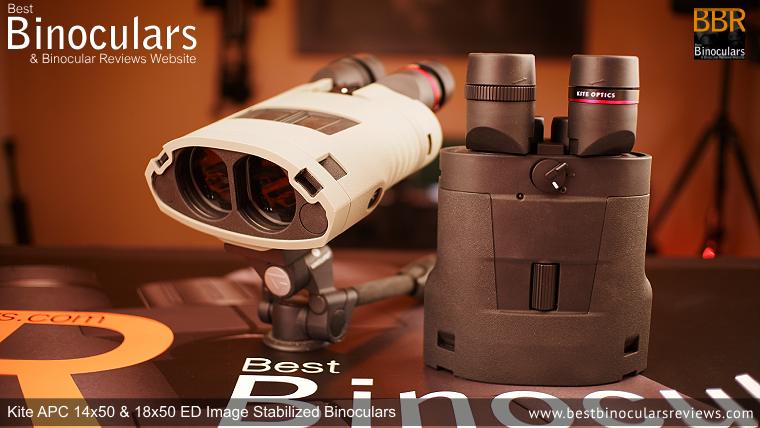
Conclusion
In terms of the technical aspects, it is hard not to be impressed, not only with the technology but the thought, level of attention and detail that Kite Optics have obviously put into these, which in my opinion now makes the idea of using an image stabilised binocular on a day-to-day basis a truly viable option.
Up until now, the negative aspects of Image Stabilized binoculars always seemed to me to outweigh the advantage that they offered over standard binoculars.:
- Very high price for the level of optics
- Large & Heavy
- Short battery life
- No or little weather protection
- Sub-standard view quality or image brightness for the price level
- Often a very narrow view because of the higher magnifications involved
In my opinion, the KITE APC 50 binoculars address all these issues and as such I can easily see myself reaching for a pair without thinking much about it and taking them out birdwatching, stargazing, travelling, or just exploring nature on a long walk.
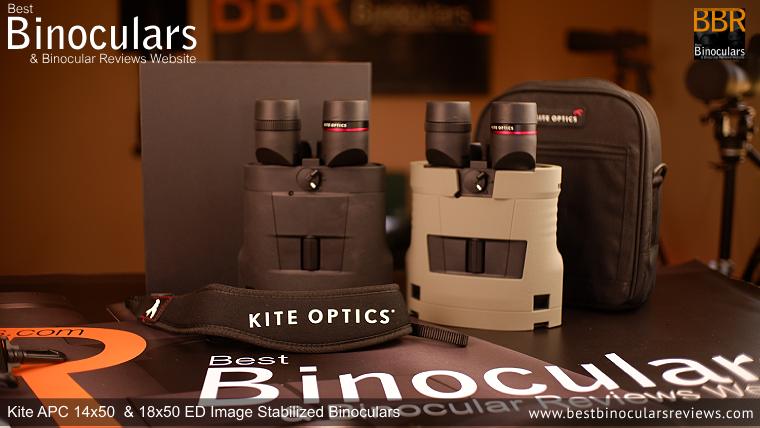
Look out for my full reviews that will cover the user experience in more detail of both the 14x50 and 18x50 KITE APC 50 binoculars which I will publish soon, until then:

 April 20, 2024 | Posted by Best Binocular Reviews
April 20, 2024 | Posted by Best Binocular Reviews 
 Categories:
Categories:  Tags:
Tags: 
